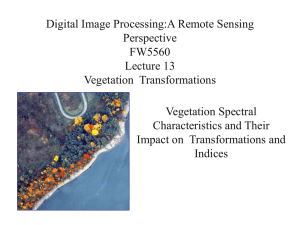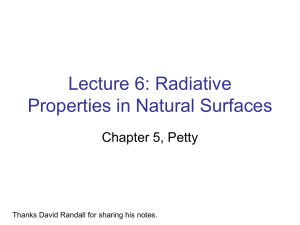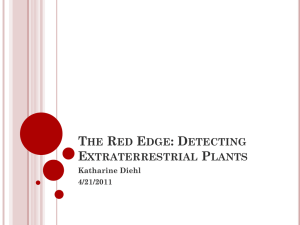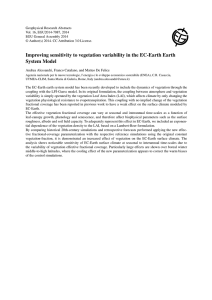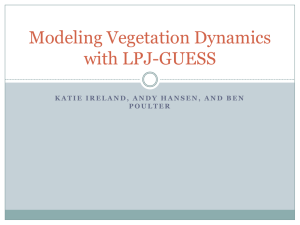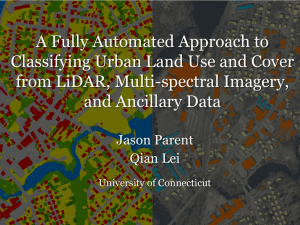class9-VIsR - University of Toronto
advertisement
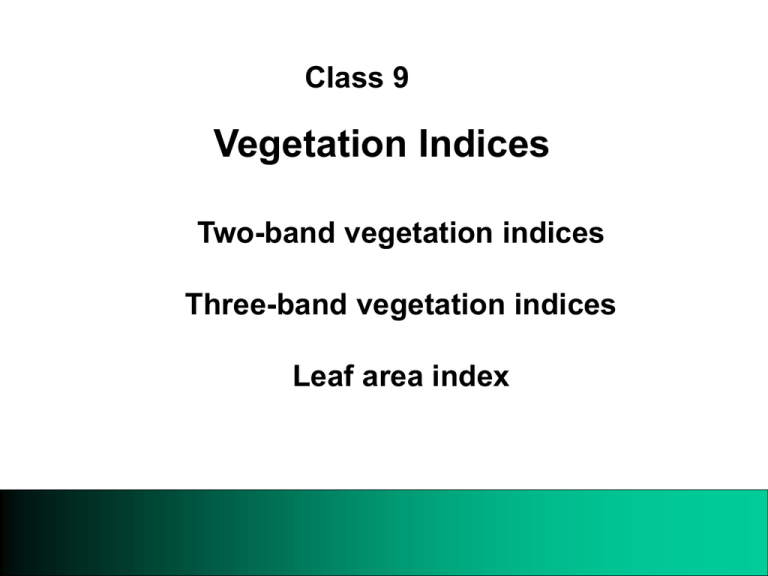
Class 9 Vegetation Indices Two-band vegetation indices Three-band vegetation indices Leaf area index Structure of a Leaf Red and blue light largely absorbed for use in photosynthesis Cuticle Upper Epidermis Strong Infrared reflectivity and transmittance. Palisade Layer Spongy Tissue Lower Epidermis and Cuticle Stomates and Guard Cells Campbell 16.3 50 40 Reflectance (%) Visible 30 Near Infrared Black Spruce Needle Moss 20 rn r 10 r BLUE 0 400 GREEN 500 RED 600 700 800 Wavelength (nm) 900 1000 Vegetation Indices • Quantitative measures for vegetation abundance and vigour. • Formed from combinations of two to several spectral bands that are added, divided, or multiplied in a manner to yield a single value that indicates the amount or vigour of vegetation within a pixel. Campbell 16.5 Leaf Area Index (LAI) LAI is defined as the total one-sided (or one half of the total all-sided) green leaf area per unit ground surface area. It is an important biological parameter because: it defines the area that interacts with solar radiation and provides the remote sensing signal; It is the surface responsible for carbon absorption and exchange with the atmosphere. Campbell 16.6 Spectral response to vegetation amount (grass) Response of Red and NIR to LAI changes in crops Martin and Heiman, 1986, Photogrammetric Engineering and Remote Sensing Reflectance croplands, grasslands Near Infrared Red LAI Campbell 16.5 Response of Red and NIR to LAI Changes Chen, 1996, Canadian Journal of Remote Sensing Forest remote sensing (Hyperspectral) Measurements 0.5 Background reflectivity (moss) Foliage reflectivity (black spruce needle) Foliage transmittance (black spruce needle) Canopy reflectance, nadir view Reflectance 0.4 0.3 0.2 Simulation 0.1 0.0 400 500 600 700 800 900 1000 Wavelength (nm) Chen and Leblanc, 2000 Forests More trees-foliage means more shadows when the density is low Reflectance Because transmittance in near-infrared is high infrared shadows appear less shaded than shadows in visible Near Infrared Red LAI Campbell 16.5 50 NDVI = rn - rr rn + rr 40 Reflectance (%) Visible 30 Near Infrared Black Spruce Needle Moss 20 rn r 10 r BLUE 0 400 GREEN 500 RED 600 700 800 Wavelength (nm) 900 1000 Vegetation Indices NDVI Normalized Difference Vegetation Index (NDVI) LAI NIR RED NDVI NIR RED Saturation problems SR Simple Ratio (SR) LAI NIR SR RED NIR = reflectance in near-infrared band RED = reflectance in red band Perpendicular Vegetation Index (PVI) Based on Eucledian distance S R VR 2 S IR VIR 2 Near Infrared reflectance PVI X S = soil, V = vegetation Y C W C: dry soil B: wet soil X: “pure” vegetation Y: Partialy vegetated pixel B A Red Reflectance Campbell 16.9 Simple Ratio (SR) SR1 > SR2 > SR3 > SR4 Near Infrared reflectance SR1 SR2 NIR SR RED SR3 SR4 Red Reflectance Normalized Difference Vegetation Index (NDVI) NDVI1 > Near Infrared reflectance NDVI1 > NDVI3 > NDVI4 NIR RED NDVI NIR RED NDVI2 NDVI3 NDVI4 Red Reflectance NDVI2 Principles of SAVI Huete, 1988, Remote Sensing of Environment Near Infrared reflectance Soil Adjusted Vegetation Index (SAVI) L SAVI1 SAVI1 SAVI2 SAVI2 > SAVI3 > SAVI4 NIR RED SAVI (1 L) NIR RED L SAVI3 SAVI4 Red Reflectance > Two-band Vegetation Indices (1) Name Formula NDVI r r n n Rouse et al., 1974 rr Jordan, 1969 n r rn 1 rr rn 1 rr MSR Chen, 1996 rn rr rn rr RDVI WDVI rr r r SR Reference a r r n , soil , Roujean and Breon, 1995 r ar n r , soil r Clevers,1989 Two-band Vegetation Indices (2) Name Formula r r 1 L r r L SAVI n , Huete, 1988 r n SAVI1 Reference L 05 . r , r r 1 L r r L n L 1 212 . NDVI WDVI r n Qi et al., 1994 r SAVI2 r 0.5 n r 0.5 2 rn rr 2 n 1 0.25 ,r 0125 . 1 r 2 r r 15 . r 0.5r r r 0.5 r GEMI r 2 n r n NLI r r 2 n n 2 2 n Pinty & Verstraete, 1992 r r r rr r Goel & Qin, 1994 Two-band Vegetation Indices:References Chen, J. M., (1996). Evaluation of vegetation indices and a modified simple ratio for boreal applications. Can. J. Remote Sensing. 22:229-242 Clevers, J. G. P. W. (1989). The applications of a weighted infrared-red vegetation index for estimating leaf area index by correcting for soil moisture. Remote Sens. Environ. 29:25-37. Goel, N. S., and Qin, W. (1994). Influences of canopy architecture on relationships between various vegetation indices and LAI and FPAR: a computer Simulation, Remote Sens. Rev. 10:309-347. Huete, A.R. (1988). A soil adjusted vegetation index (SAVI), Remote Sens. Environ. 25:295-309. Huete, A. R. and Liu, H. Q., (1994). An error and sensistivity anbalysis of the atmospheric- and soul-correcting variants of the NDVI for the MODIS-EOS. IEEE Trans. Geisci. and Remote Sens. 32:897-905. Jordan, C.F. (1969). Derivation of leaf area index from quality of light on the forest floor. Ecology 50:663-666. Kaufman, Y. J., and Tanre, D. (1992). Atmospherically resistant vegetation index (ARVI) for EOS-MODIS. IEEE Trans. Geosci. Remote Sens. 30:261-270. Pinty, B. and Verstrate, M. M. (1992). GEMI: a non-linear index to monitor global vegetation from satellites. Vegetatio 101:1520. Qi, J., Chehbouni, A., Huete, A.R., Kerr, Y.H. and Sorooshian, S. (1994). A modified soil adjusted vegetation index, Remote Sens. Environ. 48:119-126. Rouse, J. W., Hass, R. H. Shell, J. A., and Deering, D. W. (1974). Monitoring vegetation systems in the Great Plains with ERTS-1. Third Earth Resources Technology Satellite Symposium 1: 309-317. Roujean, J.-L. and Breon, F. M. (1995). Estimating PAR absorbed by vegetation from bidrectional reflectance measurements. Remote Sens. Environ. 51:375-384. Some useful features of vegetation indices (1) 1. NDVI, SR, MSR are based on the ratio of red and NIR bands. They are often preferred because the ratio can remove much measurement noise in individual bands 2. SAVI, SAVI1 and SAVI2 have the advantage of considering the influence of the soil background Effect, but it is not based on the ratio and much of Measurement noise is retained 3. Other more complicated indices might have Advantages in specific applications, but they have The potential to amplify measurement noise Chen, 1996, Canadian Journal of Remote Sensing Effectiveness of VIs in retrieving LAI of boreal forests Note: The usefulness of VIs in other ecosystems may differ Satellite-based LAI algorithm development Canada-wide LAI map validation involving all five forest research centres and several universities (satellite: Landsat; ground data: TRAC) Chen et al. 2001, Remote Sensing of Environment 60 25 50 20 40 15 SR Reflectance in the Near-Infrared band(%) LAI - Agriculture 30 10 20 5 10 0 0 1 2 3 4 5 6 Reflectance in the Red band (%) 7 8 9 0 0 1 2 LAI 3 4 Three-band Vegetation Indices Name Formula* r r Reference rrb n rrb Kaufman and Tanre, 1992 n ARVI rrb rr ( rb rr ) Liu and Huete, 1995 SARVI , r r 1 L r r L n rb n SARVI2 rb L 05 . 2.5rn rr (1 rn 6 rr 7.5rb ) Huete et al., 1996 Nemani et al., 1993 MNDVI RSR r rr r s r s min (1 ) ( rn rr ) r s max r s min n rn r s r s min (1 ) rr r s max r s min Brown et al., 1999 Three-band Vegetation Indices (References) Brown, L. J., J. M. Chen, S.G. Leblanc, and J. Cihlar. 2000. “Short Wave Infrared Correction to the Simple Ratio: An Image and Model Analysis,” Remote Sens. of Environ, . 71:16-25 Huete, A. R., C. Justice, W. van Leeuwen. 1996. “MODIS vegetation index (MOD 13)”. EOS MODIS Algorithm-Theoretical baiss document, NASA Goddard Space Flight Center, Greenbelt, Maryland 20771. USA. 115pp. Kaufman, Y. J., and Tanre, D. (1992). Atmospherically resistant vegetation index (ARVI) for EOS-MODIS. IEEE Trans. Geosci. Remote Sens. 30:261-270. Liu, H. Q. and A. R. Huete. 1995 “A feedback based modification of the NDVI to minimize canopy background and atmospheric noise.” IEEE Trans. Geosci. Remote Sens. 33:481-486. Nemani, R., L. Pierce, S. Running, and L. Band. 1993. “Forest Ecosystem Processes at the Watershed Scale: Sensitivity to Remotely Sensed Leaf Area Index Estimates,” Intl. J. Remote Sens., 14, Pp. 2519-2534. Some useful features of vegetation indices (2) 1. ARVI, SARVI, and SARVI2 are able to reduce the the influence of the atmosphere. 2. MNDVI and RSR are designed to reduce the background effects. The best way is to do proper atmospheric correction and use ratio-based indices Reduced Simple Ratio MIR MIRMIN RSR SR 1 MIRMAX MIRMIN The mid-infrared scales the background effect Brown et al, 1999 RSR SR LAI LAI a = aspen m = mixed s = spruce p = pine Brown et al, 1999, Remote Sensing of Environment
